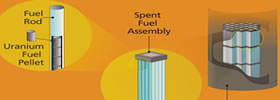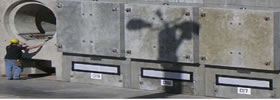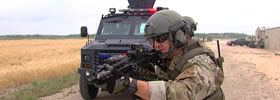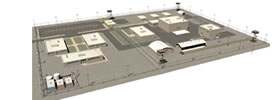
Dry Cask Storage
In the late 1970s and early 1980s, the need for alternative storage began to grow when pools at many nuclear reactors began to fill up with stored spent fuel. Utilities began looking at options such as dry cask storage for increasing spent fuel storage capacity.
Dry cask storage allows spent fuel that has already been cooled in the spent fuel pool for at least one year to be surrounded by inert gas inside a container called a cask. Dry casks typically have a sealed metal cylinder to contain the spent fuel enclosed within a metal or concrete outer shell to provide radiation shielding. In some designs, casks are set vertically on a concrete pad; in others, they are placed horizontally.
Deep Boreholes

The concept consists of drilling a boreholes into crystalline basement rock to a depth of about 5000 metres, emplacing waste canisters containing used nuclear fuel or vitrified radioactive waste from reprocessing in the lower 2000 metres of the borehole, and sealing the upper 3000 metres of the borehole with materials such as bentonite, asphalt or concrete. The disposal zone of a single borehole could thus contain 400 steel canisters each 5 metres long and one-third to half a metre diameter.
Environmentally Safe

Dry cask storage is safe and environmentally sound. Cask systems are designed to contain radiation, manage heat and prevent nuclear fission. They must resist earthquakes, projectiles, tornadoes, floods, temperature extremes and other scenarios. The heat generated by a loaded spent fuel cask is typically less than is given off by a home-heating system. The heat and radioactivity decrease over time without the need for fans or pumps. The casks are under constant monitoring and surveillance.
Response

The response force at SNRI detect illegal entry into the facility and prevent the adversary from completing their task. SNRI's response force includes on-site guards and off-site agencies including Utu's law enforcement and military personnel. SNRI's special response team's responsibility is to neutralize the adversary, by forcing capture or incapacitating the adversary.
About SNRI

SNRI was established in 1950 to serve as the primary nuclear energy research facility for the Republic of Anshar. The instititue houses various research, fuel fabrication, administrative, and plant support facilities.
The institute is located approximately 29km from Utu; Anshar's beautiful capital city.
contact us
Have questions? Need information? Looking for employment? SNRI is constantly seeking to engage with driven, innovative, and team oriented researchers, analysts, engineers. Contact us about potential research projects and joint opportunities!